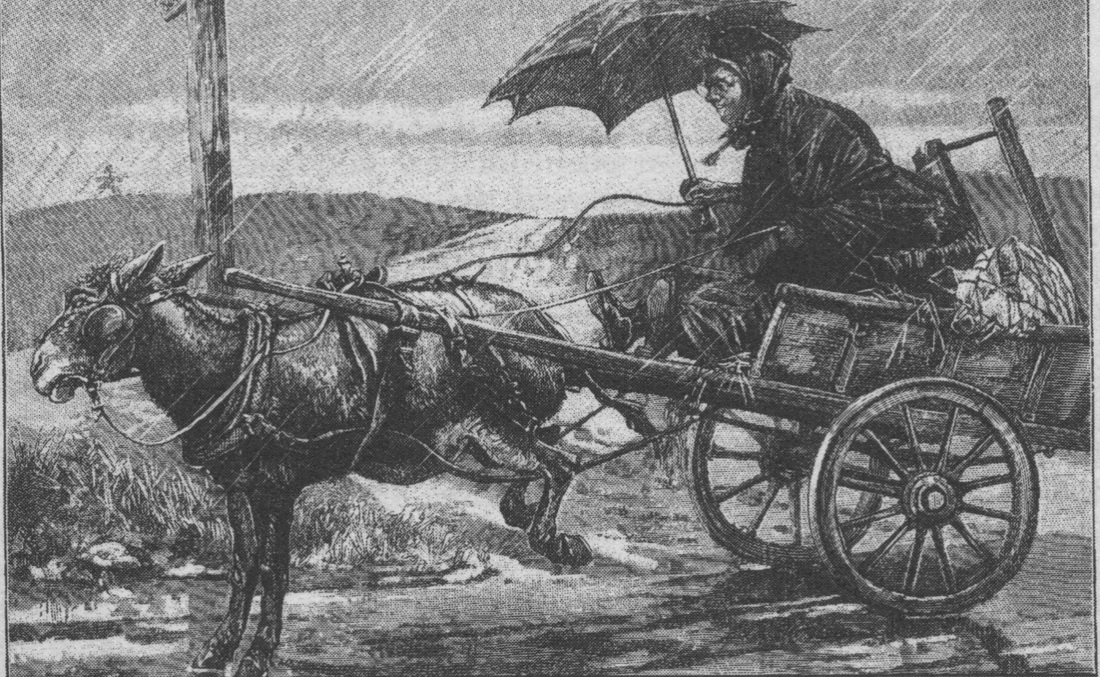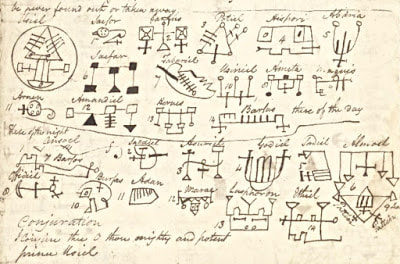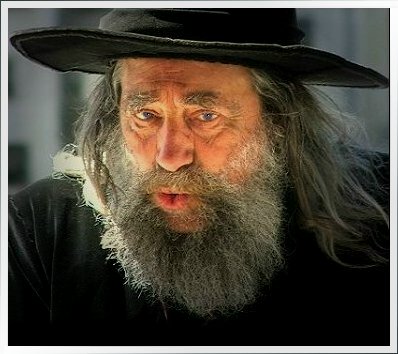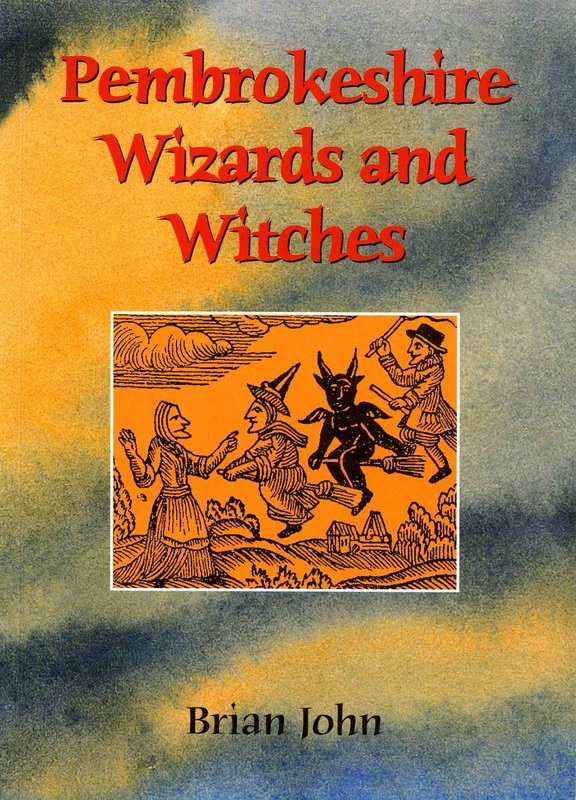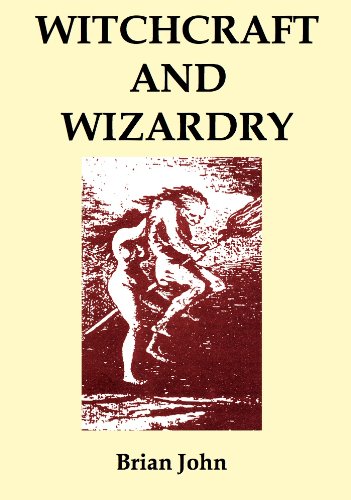Wizards and Witches
For more than 500 years wizards and witches have been accepted or tolerated in Pembrokeshire society in a manner which is quite unique in Europe. In the "witch-hunting mania" of the 1500's and 1600's, during which thousands of so-called witches were hunted down and suffered gruesome deaths at the hands of witch-hunters and hysterical groups of local people, encouraged by the religious authorities, not one witch was put to death in Wales. Witches and wizards were tolerated and even grudgingly accepted as respectable members of the community. Occasionally, if a witch became too bothersome, she would be sent on her way, but it was not considered good form to execute her, since no good might come of it........
Wizards -- the Knowing Ones
There have been many wise men or sorcerers in Pembrokeshire over the centuries, ranging from Merlin (Myrddin) the Wizard in the Dark Ages to a number of "quack doctors" in the early part of the twentieth century. Sometimes they were called "conjurors", magicians or enchanters because of their ability to perform what appeared to be magic tricks. In other cultures they might be described as sorcerers. Some who were gifted with second sight are better described as diviners or soothsayers, prophets or seers. Indeed, the type of magic practiced by wizards is called dewin in Welsh, implying divination as well as sorcery, and contact with the spirit world. Wizards are not often referred to as such in local folklore. Instead, the euphemistic Welsh term dyn hysbys (literally " knowing man") was and is used in the Welsh-speaking parts of Pembrokeshire, and this gives a good clue to the role of such men in the community. Incidentally, the experts think that the word “druid” meant “thorough knowledge”, and this might confirm the idea that wizards were the real successors of the druids. Local wizards very seldom did mischief, but were used by members of the public at a fairly mundane level for removing curses or spells and for solving problems or curing mysterious ailments. Many of them were expert herbalists, and they acted as psychiatrists, veterinarians, surgeons and even as detectives, at a time when there was no effective police force. Some of them had a quite sophisticated scientific training. They were assumed to be able to see into the future, but were generally very reluctant to foretell events because such prophecies (which were almost always correct, whether for good or ill) tended to cause great distress to others. Witches
While most (but not all) magicians or wizards have been men, most of the witches recorded in local history have been women. They have been around for a very long time, and there is evidence that they were active in pre-Christian Celtic society. In the old story of Peredur, the hero encounters nine witches and defeats them. Black witches have traditionally been those who dabbled in black magic and who have been known as capable of doing harm to ordinary folk; some were believed, like Faust, to have “sold their souls to the Devil.” White witches, in contrast, were held to be benign, using their rituals and their knowledge of magic to remove curses, heal ailments and help people. They undertook divination, and were assumed to be the inheritors of the wisdom of the druidic priestesses of two thousand years ago. A conjuration. One of the pages of Dr John Harries's Great Book, now held at the National Library of Wales
|
Joseph Harries
Everybody's favourite characted in the Saga, apart from Mistress Martha herself...
This is the famous "Wizard" of Christchurch in New Zealand -- an immensely popular figure who regales the public in the town square every day on a vast range of topics. He certainly has the gift of the gab, but we are not sure whether he is any good at magic........
Joseph Harries of Werndew probably did not look much like this! Joseph Harries of Werndew is one of the key characters in the story of Martha Morgan as recounted in the Angel Mountain Saga. He was born in 1761 and died in 1826 at the age of 65. In Martha’s time, wizards (or “knowing men”) were greatly respected. Joseph Harries really did exist -- there are a number of folk tales about him. In reality, it seems that he might not have been a very nice fellow! And he did live at Werndew, just above the village of Dinas on the north side of the mountain ridge. The cottage was, and still is, within walking distance of Carningli and Plas Ingli. But in my mind, and in the stories, Joseph is a herbalist, mystic, apothecary, surgeon, phychiatrist, sleuth, diplomat, cousellor and master of the arts of observation and deduction. He is a scientist, as well as being a man of culture, for he knows several foreign languages and is familiar with many of the esoteric books on which the world’s great religions are based. On occasion he retreats into his cottage before emerging, exhausted, with answers to very complicated questions; but there is always the possibility that he is a “confidence trickster” with a superior intellect and an ability to observe things and make deductions in the manner of a prototype Sherlock Holmes. Whether or not he is familiar with the denizens of the spirit world, he certainly does have a vast range of abilities, acquired during years of careful study under a variety of great teachers, whom he mentions every now and then. We cannot doubt that in some way he is the inheritor of the wisdom of the Druids, who were reputed to be active in this area at the time of the Roman invasion and who might have had a grove in Tycanol Wood.
Joseph is a stout and loyal friend to Martha, and a friend to many others as well. Sometimes he charges for his services, or over-charges in certain cases, on the basis that his services provided to the poor are generally not charged for. So as well as being a Sherlock Holmes, he is also by Robin Hood figure, loved by the poor and hated by the rich. He is also Martha as night in shining armor, who rides to her defence from his place across the mountain whenever he senses that she is in distress or in mortal danger. But while Joseph is always good humoured, eccentric, witty and supportive of others, he is also a tragic figure. As the stories unfold he reveals very little about himself and his family background, for as he explains to Martha, it is in his own interests to maintain an air of mystery about who he is, where he has come from, and where he will go to when his task on earth is done. But in one sensitive moment he admits to Martha that he was once married and that he lost his wife and child in childbirth. He is mortally wounded in a horrible accident, bored by a bull during the course of a routine visit requested by one of the estates. There is an irony as well as tragedy in that, since Joseph says many times that he loves working with animals. He also loves Martha from the the very beginning of the stories. This might be suspected by the reader, but Martha never realizes it until Joseph confesses it to her when he is on his death bed. Even then he can try to make light of it, and when he has gone to his grave Martha finds the situation very difficult to bear, blaming him for his foolishness in allowing his emotions to get the better of him, and her for her blindness as the reality of the situation. Joseph knows, before he dies, that his love for Martha will never be requited, because she is a member of the gentry and he is a disreputable wizard with nothing but a small cottage and a pretty garden to his name. In any case, he is almost old enough to be her father. So he loves and worships her from a distance, gaining comfort from their close and easy relationship, and some physical pleasure from their frequent embraces. He is quite a mysterious figure, and I am very fond of him! Might even be worth a story or two, when I have finished with Martha...... |
Folk Remedies
Charms
Charms have been used for centuries to bring good luck or to counteract the influence of witches. The basic idea is an ancient one, involving a very simple ritual (for example the writing out of a certain verse or the drawing of a “magic” symbol) and the belief that a token or icon can provide a protective shield around a person or a property. This simple idea was and is used all over the world, in all cultures and religions, in rural and urban communities both primitive and sophisticated. In Christianity the cross is of course the basic “charm” used to ward off evil, but other symbols assumed to provide protection are images of the Virgin Mary, relics including bits of bone, strands of hair and pieces of cloth, and the vessels used in holy communion. There is no particular logic to the use of these charms, and no scientific evidence that they actually work. All that matters is the belief system of the individual and a conviction that the charm itself is authentic and efficacious. Divination Diviners used many different techniques, some of which were unique to themselves. In the bad old days, the druids interpreted the death throes, and “read” the entrails, of human sacrificial victims. More recently, diviners might “read” the clouds or the wind, or see answers to questions in the shape of trees or in the behaviour of animals. They might use such items as keys, Bibles, holy crosses made of rowan, healing stones, pieces of cloth, bones, and wisps of hair in their work. They might use candles and pins in romantic divination, and there is a very old belief that a shoulder of mutton should be used in certain ceremonies. Cards were sometimes used for divination in urban areas, and tea-cup divination was widely practiced in Pembrokeshire. Bowls of water were used in some ceremonies, as were items of clothing and bits of straw. Mostly the rituals performed individually or in groups were designed to ascertain the identity of a future husband, or the prospects for child-bearing, or for testing the love of a suitor. Some of the text extracts on this page come from the book "Pembrokeshire Wizards and Witches" by Brian John, published in 2001 but now out of print.
The text extract relating to Joseph Harries comes from the hardback companion volume called "Martha Morgan's Little World." This is a revised edition of "Pembrokeshire Wizards and Witches" -- available as an Ebook for reading on the Kindle.
|
